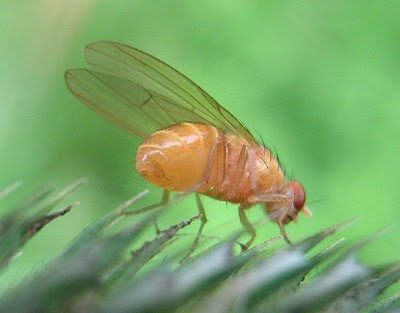The International Commission on Zoological Nomenclature just published an opinion on the name of a laboratory animal known as fruit fly, and identified as Drosophila melanogaster. Yes, that standard lab creature to sort into phenotypes during genetics classes. An application was made in 2007 requesting that if phylogenetic research would show that the fruit fly does not belong in the genus Drosophila (it has always been in the subgenus Sophophora, which then is the best candidate), the generic name should nevertheless follow it by making D. melanogaster type species of Drosophila. There was quite some discussion, difficult to understand the heat of, because the fruit fly hasn’t had its name changed yet, or anything very near. Many opposed to a potential change of the generic name for melanogaster, and supported the application. There were also voices to let taxonomy have its way, change the name if need be.
In fishes, the zebrafish, tilapias, and rainbow trout – maybe a magnitude less published on, but nevertheless important species beyond ichthyological introversions — change name in a snap the day the message comes. People were equally happy with Danio rerio then Brachydanio rerio and then Danio rerio again. Tilapias are known now mostly as Oreochromis — bothers noone. And the rainbow trout is Oncorhynchus mykiss — not Salmo gardneri (doubt very few remember this “well-known” name anymore). Entomologists may be less elastic than ichthyologists, giving them more headache and pains. Ichthyologists know that fish (no scientific name known) are a paraphyletic group, nevertheless do not demand that Pisces must be used by force.
The reflection of systematics in the names of organisms and groups of organisms is one of the strengths of Zoological Nomenclature. When a species goes from a bad to a better generic allocation based on scientific evidence it gets a new generic name, and that is a very strong signal of progress. Otherwise perhaps day-to-day taxonomic landwinnings would go unnoticed. As evidenced by thousands and thousands of nameshifts over time, this is not a challenge at all to systematics or science otherwise.
Nevertheless, as in all communities there are other opinions. One drawback of nameshifts is that literature searches get more complicated, one has to seach for two instead of one name. In some databases, such as GBIF and FishBase this is taken care of because FishBase and other databases keep synonymies and serve results under the presently valid name regardless of what name was used in the references. Not magic, hard manual work over the years. But so, if you look in older literature from Artedi onward, a large part of the species descriptions are taken up by synonymies, name lists in which authors made an effort to list all mentions of a particular species. This is not done anymore because the lists would become too long and require an amount of double-checking that few modern workers can afford. Instead we look forward to the Global Names Architecture and dependable search and retrieve databases based on resources such as ZooBank. Managing names, however, will not reduce the really major problem with the knowledgebase, namely misidentifications. A solution with misidentifications has been proposed that uses species concepts (based on stated definition of a taxon by and author) instead of named species, but that approach is not very helpful because it tends to have a different concept of the same species for every publication, and in principle makes the name independent of the species. No gain. So, we are going from Opera omnia to history-free papers, and that causes worries (about names, where the worry should be about misidentifications) and technology will need to come to rescue. And will. Someday.
Back to the fruit fly. When I was a student it was called banana fly (it is actually a vinegar fly…?), like all other small flies swarming around the fruit in the summer. What scientific name it had did not matter to teachers or students alike. And there are lots of fruit flies that are not Drosophila, D. melanogaster, or even the same family. The paraphyletic genus Drosophila as of today has 1,450 species.
The Commission has now (April 2010) issued an Opinion in response to the Application to change the type species of Drosophila to be melanogaster. The Commission says no – 23 against 4. Commissioners have different opinions, but seem to converge on the case being about taxonomy, not nomenclature, so it is not a matter for the Commission. It is also mentioned that one should not deal with hypothetical cases, as this one – actually the fruit fly is still in its old genus. You can read it all on the Commission website: ICZN Opinion on Case 3407
A Google search today finds 1,040,000 results for fruitfly (includes fruit fly); 1,570,000 for “Drosophila melanogaster”, and an astonishing 2,880,000 for Drosophila without melanogaster, suggesting that he scientific species name combination is not that worked in rock. Nonetheless, Sophophora melanogaster has currently only 93,700. Let’s see how that has changed a year or two from now.
And the winner is:
